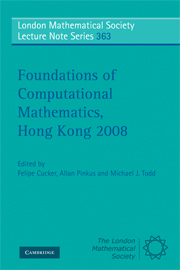Book contents
- Frontmatter
- Contents
- Preface
- Contributors
- 1 Smoothed Analysis of Condition Numbers
- 2 A World of Binomials
- 3 Linear and Nonlinear Subdivision Schemes in Geometric Modeling
- 4 Energy Preserving and Energy Stable Schemes for the Shallow Water Equations
- 5 Pathwise Convergence of Numerical Schemes for Random and Stochastic Differential Equations
- 6 Some Properties of the Global Behaviour of Conservative Low-Dimensional Systems
- 7 A Panoramic View of Asymptotics
- 8 Tractability of Multivariate Problems
7 - A Panoramic View of Asymptotics
Published online by Cambridge University Press: 07 September 2011
- Frontmatter
- Contents
- Preface
- Contributors
- 1 Smoothed Analysis of Condition Numbers
- 2 A World of Binomials
- 3 Linear and Nonlinear Subdivision Schemes in Geometric Modeling
- 4 Energy Preserving and Energy Stable Schemes for the Shallow Water Equations
- 5 Pathwise Convergence of Numerical Schemes for Random and Stochastic Differential Equations
- 6 Some Properties of the Global Behaviour of Conservative Low-Dimensional Systems
- 7 A Panoramic View of Asymptotics
- 8 Tractability of Multivariate Problems
Summary
Abstract
Asymptotic methods include asymptotic evaluation of integrals, asymptotic expansion of solutions to differential equations, singular perturbation techniques, discrete asymptotics, etc. In this survey, we present some of the most significant developments in these areas in the second half of the 20th century. Also mentioned will be a new method known as the Riemann-Hilbert approach, which has had a significant impact in the field in recent years.
Introduction
What is asymptotics? It is the branch of analysis that deals with problems concerning the determination of the behavior of a function as one of its parameters tends to a specific value, or a sequence as its index tends to infinity. Thus, it includes, for example, Stirling's formula, asymptotic expansion of the Lebesgue constant in Fourier series, and even the prime number theorem. But, in general, it refers to just the two main areas: (i) asymptotic evaluation of integrals, and (ii) asymptotic solutions to differential equations. The second area sometimes also includes the subject of singular perturbation theory. But the results in this subarea are mostly formal (i.e., not mathematically rigorous). Although occasionally one may also include the methods of asymptotic enumeration in the general area of asymptotics, the development of this area is far behind those in the two areas mentioned above. For instance, a turning point theory for difference equations was not introduced until just around the turn of this century, while the corresponding theory for differential equations was developed in the 1930's.
- Type
- Chapter
- Information
- Foundations of Computational Mathematics, Hong Kong 2008 , pp. 190 - 235Publisher: Cambridge University PressPrint publication year: 2009
- 2
- Cited by

